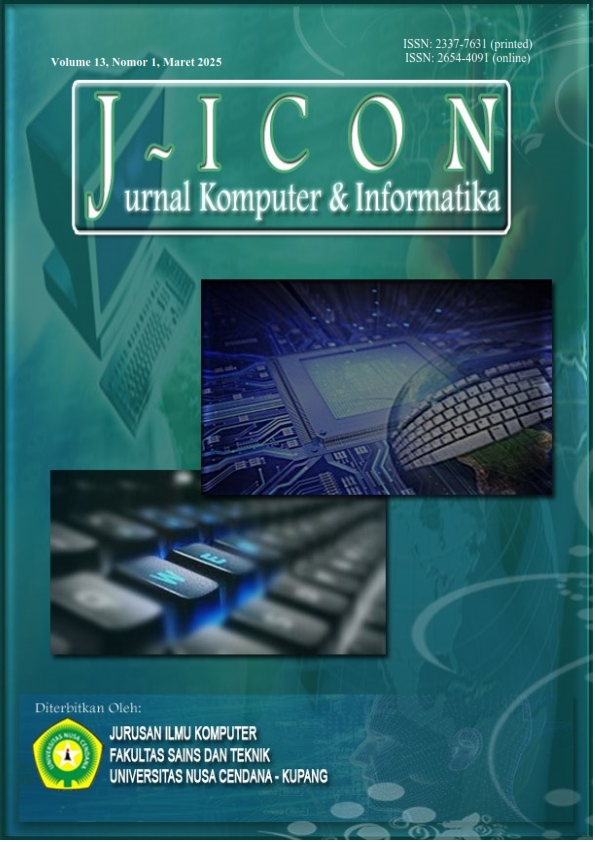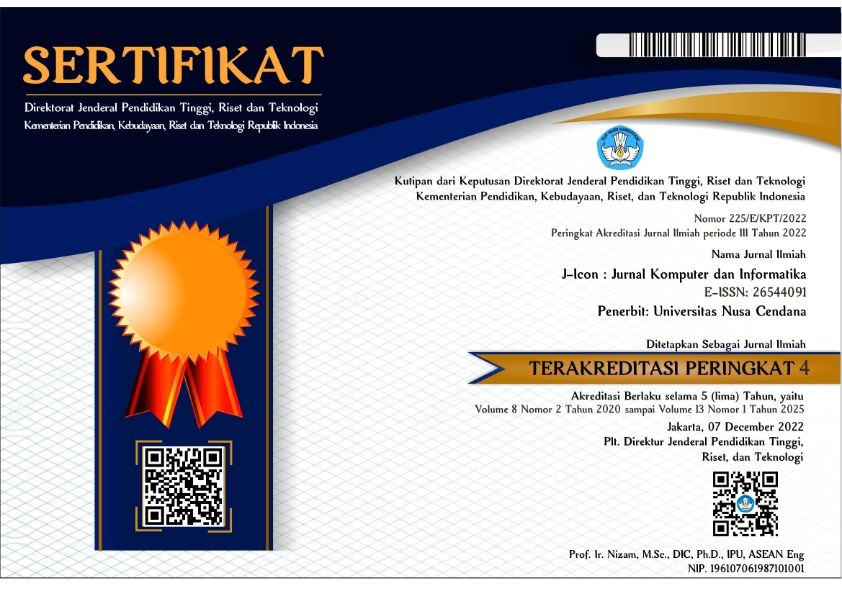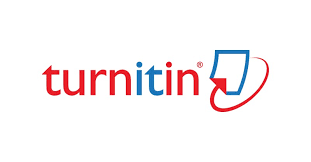APPLICATION OF K-MEANS ALGORITHM IN KINDERGARTEN SCHOOL LOCATION CLUSTERING OF SCHOOL SELECTION STRATEGY BY PARENTS
Abstract
This research aims to improve the kindergarten school location clustering model to support parents' school selection strategies. The main issue raised is the need to understand parents' preferences more deeply in choosing the right school for their children. To achieve this goal, the K-Means algorithm was applied and analyzed to cluster parents' data based on characteristics such as occupation, education, and residential location. This research utilizes a quantitative method with an exploratory descriptive approach. The results showed that the K-Means algorithm successfully formed two clusters with different characteristics. Cluster_0 includes groups with more centralized or close locations, education levels that tend to be low, and types of jobs that are at the lower middle economic level, while cluster_1 groups with more dispersed or distant locations, higher education levels, and jobs that are at higher economic levels. The quality of the resulting clusterization is considered quite good, with a Davies-Bouldin Index (DBI) value of 0.151. The application of the K-Means algorithm is proven to be effective in identifying groups of parents with different preferences, so it can be a foundation for schools in developing more targeted and tailored service strategies. This research makes an important contribution to the application of clustering techniques to support marketing strategies and decision-making in the early childhood education sector.
Downloads
References
[2] Y. Wahyudin and D. N. Rahayu, “Analisis Metode Pengembangan Sistem Informasi Berbasis Website: A Literatur Review,” J. Interkom J. Publ. Ilm. Bid. Teknol. Inf. dan Komun., vol. 15, no. 3, pp. 26–40, 2020, doi: 10.35969/interkom.v15i3.74.
[3] L. F. Az Zahroh, N. Rahaningsih, and R. D. Dana, “Klasterisasi Data Kegemaran Membaca Menggunakan Algoritma K-Means Di Sma Al-Islam Cirebon,” JATI (Jurnal Mhs. Tek. Inform., vol. 8, no. 3, pp. 2692–2698, 2024, doi: 10.36040/jati.v8i3.9543.
[4] D. Fitamaya and M. N. Zulfahmi, “Analisis Pembelajaran Moral dan Agama Melalui Penerapan Loose Part,” J. Ris. dan Inov. Pembelajaran, vol. 4, no. 1, pp. 193–207, 2024, doi: 10.51574/jrip.v4i1.1362.
[5] E. A. Saputra and Y. Nataliani, “Analisis Pengelompokan Data Nilai Siswa untuk Menentukan Siswa Berprestasi Menggunakan Metode Clustering K-Means,” J. Inf. Syst. Informatics, vol. 3, no. 3, pp. 424–439, 2021, doi: 10.51519/journalisi.v3i3.164.
[6] Z. Miftah and F. Fahrurrozi, “Digitalisasi dan Disparitas Pendidikan di Sekolah Dasar,” Ibtida, vol. 3, no. 02, pp. 149–163, 2022, doi: 10.37850/ibtida.v3i02.361.
[7] S. Suiroh, R. Astuti, and F. Muhamad Basysyar, “Implementasi Algoritma K-Means Pada Pengelompokan Data Penerimaan Peserta Didik Baru Di Smkn 1 Balongan,” JATI (Jurnal Mhs. Tek. Inform., vol. 8, no. 1, pp. 1–8, 2024, doi: 10.36040/jati.v8i1.8335.
[8] P. S. Hasugian and J. S. Raphita, “Penerapan Data Mining Untuk Pengelompokan Siswa Berdasarkan Nilai Akademik dengan Algoritma K-Means,” KLIK Kaji. Ilm. Inform. dan Komput., vol. 3, no. 3, pp. 262–268, 2022, [Online]. Available: https://djournals.com/klik
[9] S. Haviyola, S. Susilawati, and M. Jajuli, “Pengelompokan Prestasi Siswa Guna Kualifikasi Beasiswa Berdasarkan Data Nilai Menggunakan Algoritma K-Means,” JATI (Jurnal Mhs. Tek. Inform., vol. 7, no. 4, pp. 2786–2791, 2024, doi: 10.36040/jati.v7i4.7200.
[10] J. P. Tanjung, B. A. Wijaya, and M. Ridho, “Implementasi Algoritma K-Means Dalam Mengukur Tingkat Kepuasan Siswa Terhadap Pelayanan Pada SMA Swasta Bani Adam AS,” Data Sci. Indones., vol. 3, no. 1, pp. 1–11, 2023, doi: 10.47709/dsi.v3i1.2775.
[11] D. Nurdiansyah, S. Saidah, and N. Cahyani, “Data Mining Study for Grouping Elementary Schools in Bojonegoro Regency Based on Capacity and Educational Facilities,” BAREKENG J. Ilmu Mat. dan Terap., vol. 17, no. 2, pp. 1081–1092, 2023, doi: 10.30598/barekengvol17iss2pp1081-1092.
[12] Nurahman and D. D. Aulia, “Klasterisasi Pendidikan Masyarakat untuk mengetahui Daerah dengan Pendidikan Terendah menggunakan Algoritma K-Means,” J. Inform. dan Rekayasa Perangkat Lunak, vol. 5, no. 1, pp. 38–44, 2023.
[13] A. T. Basalamah and R. Setyadi, “Penerapan Algoritma K-Means Clustering Pada Tingkat Penyelesaian Pendidikan Di Provinsi Indonesia,” J. Inform. dan Teknol. Komput., vol. 4, no. 2, pp. 114–121, 2023, [Online]. Available: https://ejurnalunsam.id/index.php/jicom/
[14] K. L. Putri, M. Agus Sunandar, and Y. Muhyidin, “Penerapan Algoritma K-Means untuk Penentuan Strategi Promosi(Studi Kasus: SMA PGRI 1 Purwakarta),” JATI (Jurnal Mhs. Tek. Inform., vol. 7, no. 3, pp. 2044–2050, 2023.
[15] N. Yannuansa, M. Safa’udin, and M. I. Aziz, “Pemanfaatan Algoritma K-Means Clustering dalam Mengolah Pengaruh Hasil Belajar Terhadap Pendapatan Orang Tua Pada Mata Pelajaran Produktif,” J. Tecnoscienza, vol. 6, no. 1, pp. 43–55, 2021, doi: 10.51158/tecnoscienza.v6i1.530.
Copyright (c) 2025 Nurkhasanah Fadhila Syifa

This work is licensed under a Creative Commons Attribution 4.0 International License.
The author submitting the manuscript must understand and agree that if accepted for publication, authors retain copyright and grant the journal right of first publication with the work simultaneously licensed under a Creative Commons Attribution (CC-BY) 4.0 License that allows others to share the work with an acknowledgment of the work’s authorship and initial publication in this journal.
 Nurkhasanah Fadhila Syifa(1*)
Nurkhasanah Fadhila Syifa(1*)




